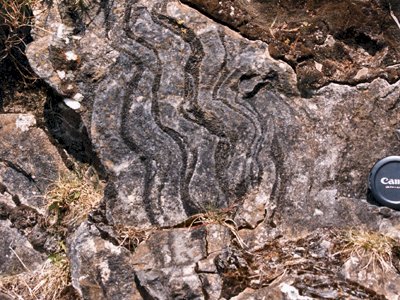Earth Science Conservation Review
| Balix Hill | Tyrone |
| Site Type: | Pit |
| Site Status: | ESCR |
| Grid Reference: | H480958 |
| Google maps: | 54.8082,-7.25348 |
| Rocks | |
|---|---|
| Rock Age: | Precambrian (Dalradian) |
| Rock Name: | Dungiven Formation |
| Rock Type: | Limestone, Phyllite |
| Interest | |
Summary of site:
On the north east flank of Balix Hill, north of Plumbridge, is a series of disused small pits previously worked for limestone that was burned in the now ruined limekiln on the site.
The limestones seen in the pits are thin, bluish-black beds separated by thinner partings of black and silvery grey phyllites (slaty looking rocks). There are some graded beds where coarse grains settled quickly through water from a mixture of different particle sizes. The coarse grains indicate the bases of beds and show that here the beds are the right way up, not overturned.
The tilt of the beds varies between 15 and 60 degrees, dipping consistently to the ESE. These are ancient Precambrian rocks of the Middle Dalradian Dungiven Formation. They predate recognisable fossils and are regionally metamorphosed (altered by deep burial and raised temperatures and pressures). In this case, temperatures reached between 300 and 500 degrees C (as indicated by the presence of temperature sensitive minerals) - not tremendously high in regional metamorphic terms.
These rocks were originally sediments that had accumulated on the shallow shelf of a major continent in the southern hemisphere, just over 600 million years ago. The continent, called Laurentia, is now split into the Canadian Shield, other parts of North America, Greenland and parts of north west Europe (including the north of Ireland and Scotland).
The site is important because conditions on the Dalradian continental shelf changed immediately after the Dungiven Formation was deposited. It is also a valuable site in elucidating the structure of the Dalradian rocks.
The limestones seen in the pits are thin, bluish-black beds separated by thinner partings of black and silvery grey phyllites (slaty looking rocks). There are some graded beds where coarse grains settled quickly through water from a mixture of different particle sizes. The coarse grains indicate the bases of beds and show that here the beds are the right way up, not overturned.
The tilt of the beds varies between 15 and 60 degrees, dipping consistently to the ESE. These are ancient Precambrian rocks of the Middle Dalradian Dungiven Formation. They predate recognisable fossils and are regionally metamorphosed (altered by deep burial and raised temperatures and pressures). In this case, temperatures reached between 300 and 500 degrees C (as indicated by the presence of temperature sensitive minerals) - not tremendously high in regional metamorphic terms.
These rocks were originally sediments that had accumulated on the shallow shelf of a major continent in the southern hemisphere, just over 600 million years ago. The continent, called Laurentia, is now split into the Canadian Shield, other parts of North America, Greenland and parts of north west Europe (including the north of Ireland and Scotland).
The site is important because conditions on the Dalradian continental shelf changed immediately after the Dungiven Formation was deposited. It is also a valuable site in elucidating the structure of the Dalradian rocks.
| Enlander, I., Dempster, M. & Doughty, P., 2025. Balix Hill, County Tyrone, site summary. [In] Earth Science Conservation Review. https://www.habitas.org.uk/escr/summary.php?item=146. Accessed on 2025-04-03 |
| Previous Site | Next Site |

